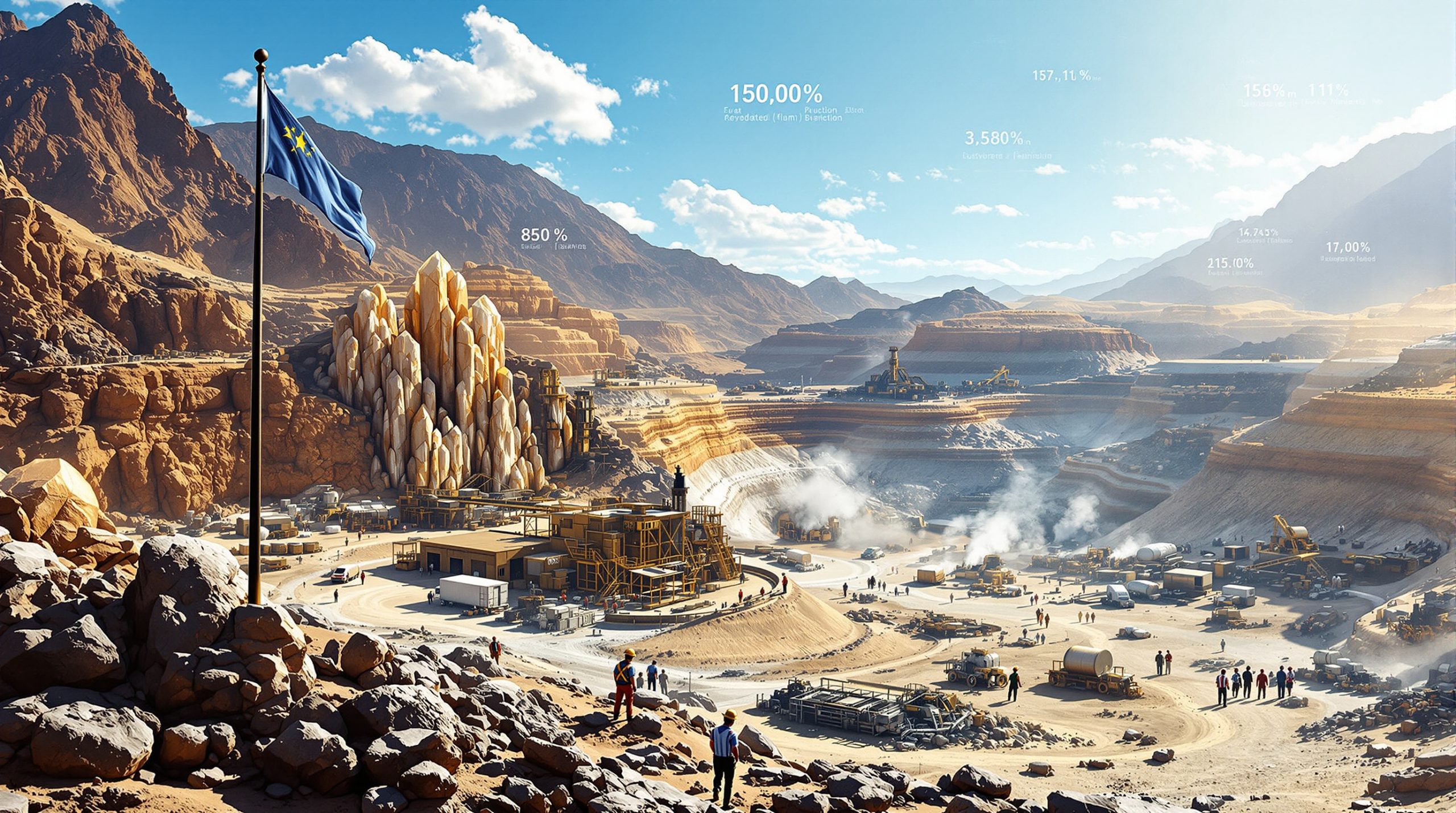Understanding the Strategic Framework
The United States and Australia have established a transformative bilateral agreement that fundamentally reshapes critical minerals diplomacy worldwide. This partnership, formalized through the US-Australia Framework for Securing of Supply in the Mining and Processing of Critical Minerals and Rare Earths, represents far more than traditional trade cooperation. Furthermore, this US-Australia rare earths pact demonstrates how democratic nations can collaborate on strategic resource security whilst addressing contemporary supply chain vulnerabilities.
President Donald Trump and Prime Minister Anthony Albanese signed this landmark accord at the White House on October 20, 2025, building upon what Albanese described as an unparalleled friendship spanning more than seven decades. The framework establishes immediate operational mechanisms designed to accelerate project development while ensuring sustained material availability for both nations' industrial requirements.
Core Investment Structure
The partnership commits substantial financial resources through a carefully structured approach. Moreover, this investment strategy aligns with broader critical minerals energy transition goals that both nations have established.
| Investment Category | US Commitment | Australian Commitment | Timeline |
|---|---|---|---|
| Initial Capital Deployment | $1 billion minimum | $1 billion minimum | Next 6 months |
| Priority Project Pipeline | Joint participation | Joint participation | $8.5 billion total value |
| Gallium Recovery Initiative | Equity investment plus offtake rights | $200 million concessional equity | Immediate implementation |
| Rare Earths Development | Equity participation | $100 million direct investment | Immediate implementation |
Source: Mining Weekly, "US, Australia back gallium and REE projects in $2bn critical minerals pact," October 21, 2025
Institutional Coordination Framework
A dedicated Critical Minerals Supply Security Response Group will oversee implementation, co-led by the US Secretary of Energy and Australia's Minister for Resources. This structure ensures rapid decision-making capabilities and streamlined project approvals across different jurisdictional frameworks. Additionally, this approach supports the development of an Australian strategic reserve that enhances both nations' resource security.
As Prime Minister Albanese emphasized: Australia is home to much of the periodic table of critical minerals and rare earth metals that are vital for defence and other advanced technologies.
Supply Chain Transformation and Market Diversification
The partnership addresses fundamental vulnerabilities in existing global supply networks by establishing alternative production centres outside traditionally concentrated sources. This strategic repositioning creates multiple pathways for essential materials reaching defence contractors, technology manufacturers, and renewable energy developers. Consequently, this diversification helps mitigate potential Trump tariffs impact on critical material flows.
Geographic Risk Mitigation
Current supply chains demonstrate dangerous concentration levels, particularly in gallium production where globally, gallium production is concentrated from a single source, and market controls have heightened interest in establishing and securing alternate supply chains, according to Mining Weekly's analysis.
This concentration creates systemic vulnerabilities during geopolitical tensions or trade disputes. The US-Australia rare earths pact establishes alternative production centres in politically stable jurisdictions with strong rule-of-law frameworks, fundamentally altering global supply dynamics.
Processing Capacity Enhancement
Beyond raw material extraction, the framework emphasises downstream processing capabilities through vertical integration. This approach ensures both countries can transform raw ores into refined products suitable for direct manufacturing applications, reducing dependency on foreign processing facilities.
Tania Constable, CEO of the Minerals Council of Australia, described the partnership as strengthening Australia's position as a dependable supplier to partners across Asia, the United States, and Europe whilst enhancing the nation's reputation as a business destination to attract necessary investment. Furthermore, this aligns with defence-critical materials strategies both nations are pursuing.
Priority Projects Receiving Immediate Support
Alcoa-Sojitz Gallium Recovery Operations
The Wagerup facility in Western Australia represents a sophisticated trilateral investment model involving Japanese participation alongside US-Australian cooperation. This integrated approach demonstrates how the framework can accommodate additional allied participation.
Key Project Details:
- Expected Annual Production: 100 metric tons of gallium
- Australian Investment: $200 million in concessional equity
- US Involvement: Equity investment plus offtake rights
- Operational Model: Alcoa-operated facility
- Current Status: Completing feasibility assessments
The project capitalises on gallium's natural presence in bauxite during alumina refining processes. William Oplinger, President and CEO of Alcoa, stated the company welcomes the opportunity to support both nations in progressing a new source of gallium, building on Alcoa's strong contributions to both American and Australian economies.
Japanese Partnership Component:
- Entity: Japan Australia Gallium Associates (JAGA)
- Structure: Joint venture between Japanese government and Sojitz Corporation
- Timeline: Joint development agreement with Alcoa announced August 2025
- Integration: US, Australia, and Alcoa special purpose vehicle would enter joint venture with JAGA
Arafura Rare Earths Nolans Project
The Northern Territory-based Nolans Project positions itself as a major supplier capable of meeting 5% of global rare earths demand once operational. This fully integrated ore-to-oxide facility addresses both light and heavy rare earth elements essential for renewable energy infrastructure.
Project Specifications:
- Investment Amount: $100 million in equity
- Global Market Impact: 5% of total global rare earths production
- Integration Level: Complete ore-to-oxide processing
- Output Diversity: Both light and heavy rare earth elements
- Strategic Importance: One of only two priority projects receiving immediate financial commitments
Darryl Cuzzubbo, Managing Director and CEO of Arafura Rare Earths, emphasised that the nascent rare earth sector represents an imperative rather than merely a prospect. He highlighted unprecedented supply chain disruptions observed since April 2025, noting the necessity of thoughtful supply chain diversification for long-term security.
Cuzzubbo further indicated that with demand for both light and heavy rare earths forecast to grow significantly over the next three decades, Arafura's integrated project positions the company to meet a disproportionate share of that future growth. This development reflects broader trends in mining industry evolution towards strategic partnerships.
Strategic Differentiation from Previous Agreements
Accelerated Implementation Timeline
Unlike traditional trade agreements requiring years of negotiation, this framework prioritises immediate capital deployment within six-month windows rather than extended development cycles. Both governments commit substantial resources through streamlined approval mechanisms that fast-track project development.
Tania Constable noted the framework includes joint commitment to fast-track approvals, acknowledging Australia's strategically important role in developing new technologies, defence capabilities, and renewable energy infrastructure stemming from the nation's array of critical minerals.
Defence-Economic Integration
The partnership explicitly connects mineral security with defence cooperation, recognising these materials as strategic assets rather than purely commercial commodities. Prime Minister Albanese stated: Cooperation on critical minerals and rare earth supply chains is testament to the trusted partnership between Australia and the United States as strategic defence allies.
This integration aligns resource development with national security priorities, creating precedents for how democratic nations can collaborate on strategic resource security whilst building alternatives to dependency relationships with authoritarian suppliers.
AUKUS Framework Extension
Constable described the agreement as AUKUS in action, demonstrating how the existing security partnership between Australia, UK, and US enables broader coalition approaches to supply chain security. This model establishes templates that could extend to other critical materials and additional allied participants.
Addressing Current Market Vulnerabilities
Supply Disruption Context
Recent months have exposed significant supply chain vulnerabilities, as Arafura's leadership referenced unprecedented disruptions to global trade observed since April 2025. These disruptions highlighted the urgent need for thoughtful diversification to secure foundational, long-term solutions. Moreover, the Australia-US critical minerals framework addresses these vulnerabilities through structured cooperation.
Critical Applications Impact
Gallium Strategic Importance:
- Primary Applications: Semiconductor manufacturing, defence electronics
- Industry Dependency: Critical for technology sectors, especially semiconductors and defence
- Current Vulnerability: Single-source concentration globally
- Market Response: Heightened interest in alternate supply chain establishment
Rare Earths Applications:
- Renewable Energy: Essential for wind turbine magnets, electric vehicle motors
- Defence Systems: Critical for advanced electronics and guidance systems
- Technology Manufacturing: Required for energy storage systems and high-performance electronics
- Growth Trajectory: Significant demand increases forecast over next three decades
Economic Implications and Market Impact
Australian Resource Sector Development
The partnership accelerates domestic value-addition within Australia's mining industry, transitioning beyond traditional ore export models toward higher-value processed materials. This transformation creates employment opportunities in technical processing roles whilst generating increased export revenues.
The Minerals Council emphasised the partnership would encourage greater investment in Australian mining and processing at a time when such investment is urgently required to unlock the nation's next prosperity chapter.
US Manufacturing Competitiveness
Secured access to critical materials enables American manufacturers to plan long-term production strategies without supply disruption concerns. This stability particularly benefits defence contractors and technology companies requiring consistent material inputs for advanced manufacturing processes.
Global Market Dynamics
Additional supply sources typically moderate price volatility by reducing single-supplier market power. The partnership's production targets suggest meaningful capacity additions that could influence global pricing dynamics whilst providing manufacturers with alternative suppliers during disruptions. However, the US-Australia rare earths pact must navigate existing market complexities.
Implementation Challenges and Risk Factors
Technical Development Complexity
Converting resource deposits into operational facilities requires substantial technical expertise and infrastructure development. Both flagship projects must overcome significant engineering challenges whilst meeting aggressive production timelines established under the framework.
Specific Technical Hurdles:
- Gallium Extraction Integration: Incorporating gallium recovery into existing alumina refining processes
- Rare Earths Processing: Developing complete ore-to-oxide processing capabilities
- Quality Standards: Meeting defence and technology industry specifications
- Scale Requirements: Achieving targeted production volumes economically
Regulatory Coordination Requirements
Aligning approval processes across different regulatory frameworks requires ongoing coordination between government agencies. Streamlined permitting becomes essential for meeting accelerated development schedules whilst maintaining environmental and safety standards.
Market Competition Response
Existing suppliers may adjust pricing strategies or accelerate their own capacity expansions in response to new market entrants. This competitive dynamic could influence the partnership's market penetration success and long-term viability.
Technology Supply Chain Implications
Semiconductor Industry Benefits
Gallium availability directly affects semiconductor production capacity, particularly for high-performance applications in defence and telecommunications sectors. The Wagerup facility's 100 metric tons annual production provides secured supply sources enabling more predictable manufacturing planning for chip producers.
Specific Semiconductor Applications:
- Gallium Nitride (GaN) Devices: High-frequency, high-power electronics
- Gallium Arsenide (GaAs) Components: Advanced telecommunications equipment
- Defence Electronics: Military-grade semiconductor systems
- Power Management: High-efficiency power conversion systems
Renewable Energy Sector Support
Rare earths remain essential for wind turbine magnets, electric vehicle motors, and energy storage systems. The Nolans Project's capacity to supply 5% of global rare earths demand supports renewable energy deployment goals by reducing material procurement uncertainties.
With demand growth forecasted significantly over the next three decades, diversified supply sources become critical for maintaining renewable energy expansion momentum whilst avoiding supply bottlenecks that could constrain clean energy transitions.
Geopolitical Context and Strategic Outcomes
Allied Cooperation Evolution
The partnership exemplifies how democratic nations collaborate on strategic resource security, creating alternatives to dependency relationships whilst strengthening alliance architectures. This cooperation model demonstrates economic and security policy intersection in contemporary international relations.
The framework establishes precedents for resource-based cooperation that could influence future alliance structures, particularly as nations recognise the strategic importance of material supply chains for maintaining technological leadership and industrial competitiveness.
Long-term Industrial Base Strengthening
Secured access to critical materials enables both nations to maintain and expand their advanced manufacturing capabilities, supporting innovation in defence technologies, renewable energy systems, and next-generation electronics manufacturing.
Future Market Projections and Growth Potential
Production Capacity Timeline
The partnership's immediate focus on two major projects provides concrete benchmarks for measuring supply chain diversification progress. Furthermore, these timelines demonstrate how the US-Australia rare earths pact creates tangible outcomes.
Near-term Production Targets:
- Gallium Recovery: 100 metric tons annually from Wagerup facility
- Rare Earths Output: 5% of global production from Nolans Project
- Implementation Timeline: Feasibility completion and construction phases
- Market Entry: Operational status within framework timeline
Demand Growth Alignment
Industry projections indicate substantial growth in critical minerals demand driven by renewable energy expansion, electric vehicle adoption, and defence modernisation programmes. The partnership positions both nations to capture significant market share in these expanding sectors.
Investment Framework and Financial Structure
Capital Deployment Strategy
The $2 billion minimum commitment equally split between both governments demonstrates serious financial dedication to supply chain transformation. This funding supports not only immediate project development but establishes mechanisms for ongoing investment coordination.
Investment Allocation Priorities:
- Immediate Project Support: Direct equity investments in priority projects
- Infrastructure Development: Supporting facilities and processing capabilities
- Technology Transfer: Advanced processing and extraction methodologies
- Market Development: Establishing secure offtake agreements and supply contracts
Concessional Financing Mechanisms
Australia's $200 million concessional equity commitment to the gallium project demonstrates innovative financing approaches that reduce project risk whilst maintaining commercial viability. These mechanisms could serve as templates for future critical minerals investments.
The partnership represents more than bilateral trade cooperation – it establishes a new paradigm for resource diplomacy that prioritises strategic security alongside economic benefits. Through substantial financial commitments, accelerated project timelines, and institutional coordination mechanisms, this framework creates pathways for reducing supply chain vulnerabilities whilst supporting both nations' technological advancement and industrial competitiveness.
As global competition intensifies around critical materials access, such partnerships become essential templates for maintaining democratic nations' technological leadership whilst building resilient supply chains for the advanced technologies that will define economic and security landscapes in coming decades.
This analysis is based on information from Mining Weekly's comprehensive reporting on the US-Australia critical minerals framework, providing detailed coverage of global mining industry developments and strategic resource partnerships.
Ready to Capitalise on Critical Minerals Investment Opportunities?
The US-Australia rare earths pact creates significant opportunities for savvy investors to identify emerging ASX-listed companies positioned to benefit from this $2 billion strategic partnership. Discovery Alert's proprietary Discovery IQ model delivers real-time notifications on mineral discoveries across critical materials sectors, empowering subscribers to spot actionable trading opportunities before the broader market recognises their potential. Explore historic examples of exceptional discovery returns on Discovery Alert's dedicated discoveries page and begin your 30-day free trial today to position yourself ahead of this transformative market shift.




